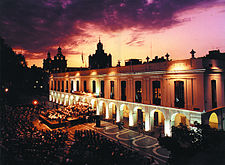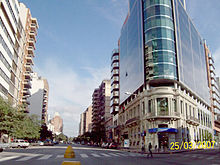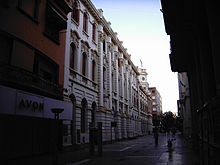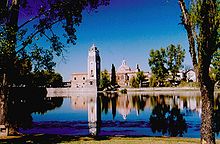- Córdoba Province, Argentina
-
Córdoba — Province — Clockwise from top: Estancia of Alta Gracia, Córdoba City, Sierras de Córdoba range, Jesuit Block. 
Flag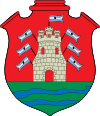
Coat of armsLocation of Córdoba within Argentina Country Argentina Capital Córdoba Departments 26 Municipalities and communes 427 Government – Governor Juan Schiaretti (PJ) – Legislature 70 – National Deputies
18– National Senators Luis Juez, Norma Morandini, Ramón Mestre Jr. Area
Ranked 5th– Total 165,321 km2 (63,830.8 sq mi) Population (2010[1]) – Total 3,304,825 (Ranked 2nd) Demonym cordobés Time zone ART (UTC−3) ISO 3166 code AR-X Website www.cba.gov.ar Córdoba (Spanish pronunciation: [ˈkorðoβa]) is a province of Argentina, located in the center of the country. Neighboring provinces are (clockwise from the north): Santiago del Estero, Santa Fe, Buenos Aires, La Pampa, San Luis, La Rioja and Catamarca. Together with Santa Fe and Entre Ríos, the province is part of the economic and political association known as the Center Region.
Córdoba is the second most populous Argentine province, with 3,304,825 inhabitants[2], and the fifth by size, at about 165,321 km². Almost 41% of its inhabitantes reside in the capital city, Córdoba, and its sourroundings, making it the second most populous metro area in Argentina.
Contents
History
Before the Spanish conquista the region now called Córdoba Province was inhabited by indigenous groups, most notably the Comechingones and Sanavirones.
Once settled in Alto Perú, the Spaniards searched for a route to the Río de la Plata port in the Atlantic Ocean to transport the Peruvian gold and silver to Europe.
Córdoba de la Nueva Andalucía (nowadays the city of Córdoba) was founded as a middle point on that route on July 6, 1573 by Jerónimo Luis de Cabrera. The Colegio Convictorio de Nuestra Señora de Monserrat was founded by the Jesuits in 1599, followed by the National University of Córdoba, Argentina's first university, in 1622. The city continued to grow as an important cultural center, supported by the trade of precious metals from Perú. In 1761 a printing press was installed in the University.
In 1783, seven years after the consolidation of the Viceroyalty of the Río de la Plata, the Intendency of Córdoba became the capital of what now includes the La Rioja, Mendoza, San Juan and San Luis Province, dividing the former Tucumán Intendency in two. Rafael de Sobremonte was its first governor, when Córdoba City had 38,800 inhabitants.
After the May Revolution in 1810, Governor Juan Gutiérrez de la Concha joined a meeting that decided to ignore the authority of the Buenos Aires Junta. Francisco Ortiz de Ocampo attacked the city and executed the leaders of the opposition, among whom was Santiago de Liniers, leader of the resistance during the British invasions of the Río de la Plata.
Led by Juan Bautista Bustos after 1820, Córdoba struggled for control of the Nation with Buenos Aires; the United Provinces of South America had neither legislative nor executive branches at the time. Córdoba sought a federal organization of the provinces while Rivadavia pushed for a centralised government in Buenos Aires. For 15 years the province was submerged in internal revolts that started to stabilize in 1868 under the provisional government of Félix de la Peña.
During the presidency of Sarmiento an astronomic observatory (1871) and the Faculty of Physic Sciences and Mathematics (1873) were inaugurated.
The creation of the railways and the consequent immigration brought a second wave of population growth to Córdoba. From 1887 on, several agricultural colonies (San Francisco, Marcos Juárez, etc.) emerged, while former rest-point Fraile Muerto (Bell Ville), Ferreira (Villa María) and Los Luceros (Río Segundo), on the route to Buenos Aires, became agricultural, commercial and industrial centers, respectively.
The University Reform movement, which originated in Córdoba in 1918, was influential not only in Argentina but throughout South America. Modernization of the curricular contents and the improvement of the students' rights were the main achievements of the movement and in Córdoba, and were largely enacted by Governor Amadeo Sabattini, who became Argentina's most progressive governor at the time and enacted civil and land reforms that would later set the national standard.
After World War II, many foreign workers and workers from other provinces in Argentina were seduced by Córdoba's industrial development, led by the expansion of the car industry. It was during Arturo Frondizi's presidency (1958–1962) that most new auto industries settled in the city of Córdoba and its surroundings.
As in the rest of the country, Peronist groups emerged in 1955 following the coup that removed Juan Perón from office. These Peronist groups, together with other socialist and anarchist groups, began opposing Argentina's third military dictatorship that began in 1966. Worker and student participation in politics grew due to the widespread discontent with the appointed governor's hard-line stance, culminating in the violent May, 1969, popular revolt known as the Cordobazo. This revolt, mirrored by the Rosariazo and others in several parts of the country, undermined the power of dictator Juan Carlos Onganía and ultimately led to his ouster by more moderate military factions.
Córdoba has continued to prosper, despite left-wing violence in 1973, right-wing political interference in 1974, government atrocities in 1976–77, 1978–81 free trade policies that battered Córdoba's sizable industrial sector, the 1980s debt crisis and, the recent acute financial crisis that ended in 2002.
Geography and Climate
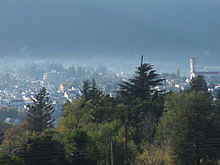 La Falda and the Córdoba Sierras foothills.
La Falda and the Córdoba Sierras foothills.
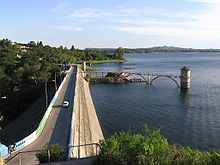 Rio Tercero Reservoir.
Rio Tercero Reservoir.
Córdoba, located just north of the geographical center of the nation, is Argentina's 5th largest province. The main feature of the province is the presence of an extensive plain covering the eastern two thirds of the province, and the existence of three major mountain ranges which, combined, are known as Sierras de Córdoba: the easternmost range starts just west of the city of Córdoba and reaches altitudes of mostly around 1,000 meters (3,280 ft) in the southern portion, and over 1,500 meters (4,900 ft) further north, with a maximum altitude of 1,950 meters (6,400 ft) at Cerro Uritorco. West of this chain, two valleys contain most of the tourist spots in the province: the Calamuchita valley in the south, and the Punilla Valley in the north, home of scenic towns such as Villa Carlos Paz, Cosquín, La Cumbre and La Falda.
West of these valleys, the Sierras Grandes form the highest chain in the province: their altitude increases gradually to form a plateau 0f 2,000 to 2,300 meters (6,500 to 7,500 ft) known as Pampa de Achala, culminating with Cerro Champaqui on the western part, at 2,790 meters (9,150 ft). West of these mountains, there is an impressive drop towards the valley known as Valle de Traslasierra, and across the valley, the Sierras Orientales reach an altitude of 1,650 meters (5,400 ft) at Cerro Yerba Buena. On the northeast corner of the province, a natural depression forms an extensive salt lake called Laguna Mar Chiquita. The actual surface of the lake is 6,000 km² (15,000 mi²), but during extended dry periods (such as in the 1980s) it can be a third of that, with much higher salinity. The southeastern part of the province is home to numerous ponds, lakes and wetlands.
The climate of the province is predominantly temperate, with some regional variations. Generally speaking, summers are hot and humid, falls are pleasant, winters are extremely dry with strong variations in temperature, and springs are windy and variable. The eastern part of the province experiences summer average high temperatures between 30°C and 32°C (86F to 90F) and lows of 16°C to 18°C (60F to 64F), with frequent thunderstorms, heat waves with temperatures higher than 38°C (100F) alternating with periods of much dryer, pleasant weather following cold fronts. Monthly precipitation during this season ranges from 90 mm to 120 mm (3.5 to 4.7 inches). Nights are noticeably cooler in March, which is also the rainiest month, and April often brings very pleasant weather with highs around 23°C (73F) and lows around 11°C (52F). Starting in May, rainfall is low, with less than 25 mm (1 in) monthly during the winter. Frost arrives in late April in the south, and late May in the north.
Winter temperatures average a high of 15°C to 18°C (59F to 64F) and lows of 2°C to 4°C (36F to 39F), but marked variations are possible: northerly winds can push values up to 30°C (86F) and southerly winds can keep afternoon temperatures at 6°C (42F) and bring nighttime temperatures to -5°C (23F). The air is often humid in winter, and thick fog is very common. Snowfall is very rare, almost unheard of in the northeast, but snowstorms can occur: in 2007, between 10 cm and 20 cm (4 in to 8 in) covered a significant part of the region, and temperatures plummeted to -9°C in most areas (16F). Spring is very variable, alternating between very intense heat waves and cool weather periods with severe thunderstorms, hail and strong winds. Total precipitation is over 850 mm (33.5 in) along the border with Santa Fe, and diminishes to about 700 mm (27.5 in) in the west, reaching a minimum of about 600 mm (23.5) in the southernmost part of the province. This climate allows eastern Córdoba to be the nation's main producer of soybeans and peanuts, and a large producer of maize and dairy products.
The foothills of the Sierras are known for their pleasant weather: summer days are slightly cooler and the air feels much dryer despite high precipitation; winters are much dryer with less fog and less wind, and more pleasant sunny days. The eastern slopes of the sierras experience the highest precipitation: usually about 900 mm (35.5 in), with some spots averaging up to 1200 mm (47 in) which fall exclusively in the form of very heavy thunderstorms in the summer. Snowfall occurs more frequently in the sierras, but is rarely heavy due to the dryness of the air.
The weather in the Pampa de Achala is very variable because of the high altitude: generally speaking, the strong radiation provides pleasant summer afternoons, but temperatures at night can be very cold. Frost can happen throughout the year, and winters are extremely dry with nights well below 0°C (32F). Temperatures well under -15°C (5F) have been recorded, and snowfall is very common but in small quantities due to the lack of precipitation during the colder months. Summer thunderstorms can be very violent, bringing large hail, frequent lightning and high winds.
The region of Traslasierra is known for its markedly warmer climate: summer temperatures often reach well over 35°C (95F) and nights are often very warm. Fall arrives later than elsewhere, and spring arrives earlier as well. Winters are pleasant, with common light frost followed by very pleasant afternoons reaching about 19°C (66F). Precipitation is even more seasonal than in the rest of the province, falling exclusively in the summer, and reaching a total of 500 mm (24 in) to 700 mm (27.5 in). The warmer climate is excellent for the production of Mediterranean agricultural products such as figs, olives and grapes. The extreme northern and northwestern areas of the province are located on the transition between the temperate Pampa and the subtropical Gran Chaco: summers are consistently longer and warmer than in other areas, and extremes of 40°C (104F) are more frequent. Winters are shorter, with night temperatures similar to those further south, but with warmer days. This is the most drought-prone area of the province, with rainfall as little as 400 mm (15.5 in) annually.
Economy
Córdoba has the second largest provincial economy in Argentina, behind only the Province of Buenos Aires. Córdoba's GDP was estimated at US$27.7 billion in 2006 and has long contributed about 8% of the national GDP. Its per capita income (US$9,040) is slightly above the national average.[3]
Agriculture and livestock provide 10% of the province's output,[4] well above the national average. The agriculture is centered around soybeans, wheat and maize, and other cereals. Cattle and sheep enjoy the grass of Córdoba's green hills. The province provides the nation with 15% of its beef production and 28% of its dairy output. The food industry around oil, milk and cereal derivatives is also very important, candy maker Arcor being one of the most important.
The installation of the Fábrica Militar de Aviones in 1927, and subsequent state-owned industries established Córdoba among the most important industrial centers in Argentina; the facility was purchased by Lockheed Martin in 1995. Beginning around 1955, foreign investment in Córdoba's automotive, agricultural machinery and food processing industries further added to its industrial profile. Today, 250 manufacturers of either motor vehicles or auto parts operate in Córdoba, making it Argentina's "motor province." Industry represents another 17% of the province's income, and the energy production that supports it is based mainly on 15 hydroelectric dams (2.35 billion kW/hours a year), and the Embalse nuclear power plant (600 MWe of capacity, about 2 billion kWh, yearly).
Mining includes many different minerals, and construction material such as marble and lime. Uranium is also extracted to feed Argentina's three atomic plants.
Tourism, as in the rest of Argentina, is a growing industry favoured by the mild climate, a number of small rivers, and low green hills. Around three million tourists, both foreign and Argentinian, visit Córdoba every year. The province has 500,000 hotel beds, including hostels, tourist farms and other types of accommodation. There are four five-star hotels[5], of which three are located in Cordoba City (Sheraton Cordoba Hotel, Holiday Inn, Interplaza), and one on the hills at Punilla Valley (El Castillo). Important festivities include the Cosquín National Folk Music Festival, and the Jesús María Folk and Taming Festivals.
Córdoba is connected by rail with Buenos Aires, Rosario, Mendoza and Tucumán. The Ingeniero Ambrosio L.V. Taravella International Airport, known as Pajas Blancas, handles international and domestic air traffic, while the Las Higueras Río Cuarto Airport handles only domestic flights.
Government
Córdoba has a unicameral legislature elected by universal suffrage. Until December 2001, the legislature was bicameral (a Chamber of Deputies and a Senate), but following the 2001 constitutional reform, this division was abolished. The unified legislature is made up of 70 members: 26 elected to represent each of the provincial departments, and 44 elected by the people of the province as a whole and assigned by a proportional system.[6]
The head of government is the governor, accompanied by a vice-governor who presides the legislature and may fill the governor's place in certain cases. Like the legislators, the governor and vice-governor are elected for a four-year term, and can be re-elected for one consecutive term.
Córdoba has long been a bastion of the centrist Radical Civic Union, but in 1999 the Justicialist José Manuel de la Sota was elected governor, succeeded by fellow Peronist Juan Schiaretti in 2007.
Political divisions
The province is divided in 26 regions or departments (Spanish: departamentos) here listed with their regional capitals.
See also
References
- ^ [1]
- ^ Proyecciones y estimaciones de población 2001-2015 - INDEC - Pág 16.
- ^ I.A.D.E.R
- ^ Prospecting Argentina
- ^ Cordoba Province Official Hotel List
- ^ Constitution of the Province of Córdoba (14 September 2001). Biblioteca Virtual Miguel de Cervantes. (Spanish)
External links
- Official Executive Power Site (Spanish)
- Official Legislative Power Site (Spanish)
- Official Judicial Power Site (Spanish)
- La Voz del Interior daily Newspaper (Spanish)
- La Mañana de Córdoba daily Newspaper (Spanish)
- El Diario del Sur de Córdoba daily Newspaper edited in Villa María (Spanish)
- Cordoba Regions
- Capillas y Templos de la Provincia de Córdoba - Argentina
- Tanti, en el corazón de Córdoba - Argentina
- Tourism in Cordoba Argentina. (Spanish)
Provinces of Argentina Provinces Buenos Aires · Catamarca · Chaco · Chubut · Córdoba · Corrientes · Entre Ríos · Formosa · Jujuy · La Pampa · La Rioja · Mendoza · Misiones · Neuquén · Río Negro · Salta · San Juan · San Luis · Santa Cruz · Santa Fe · Santiago del Estero · Tierra del Fuego · Tucumán

Autonomous city
Wikimedia Foundation. 2010.



